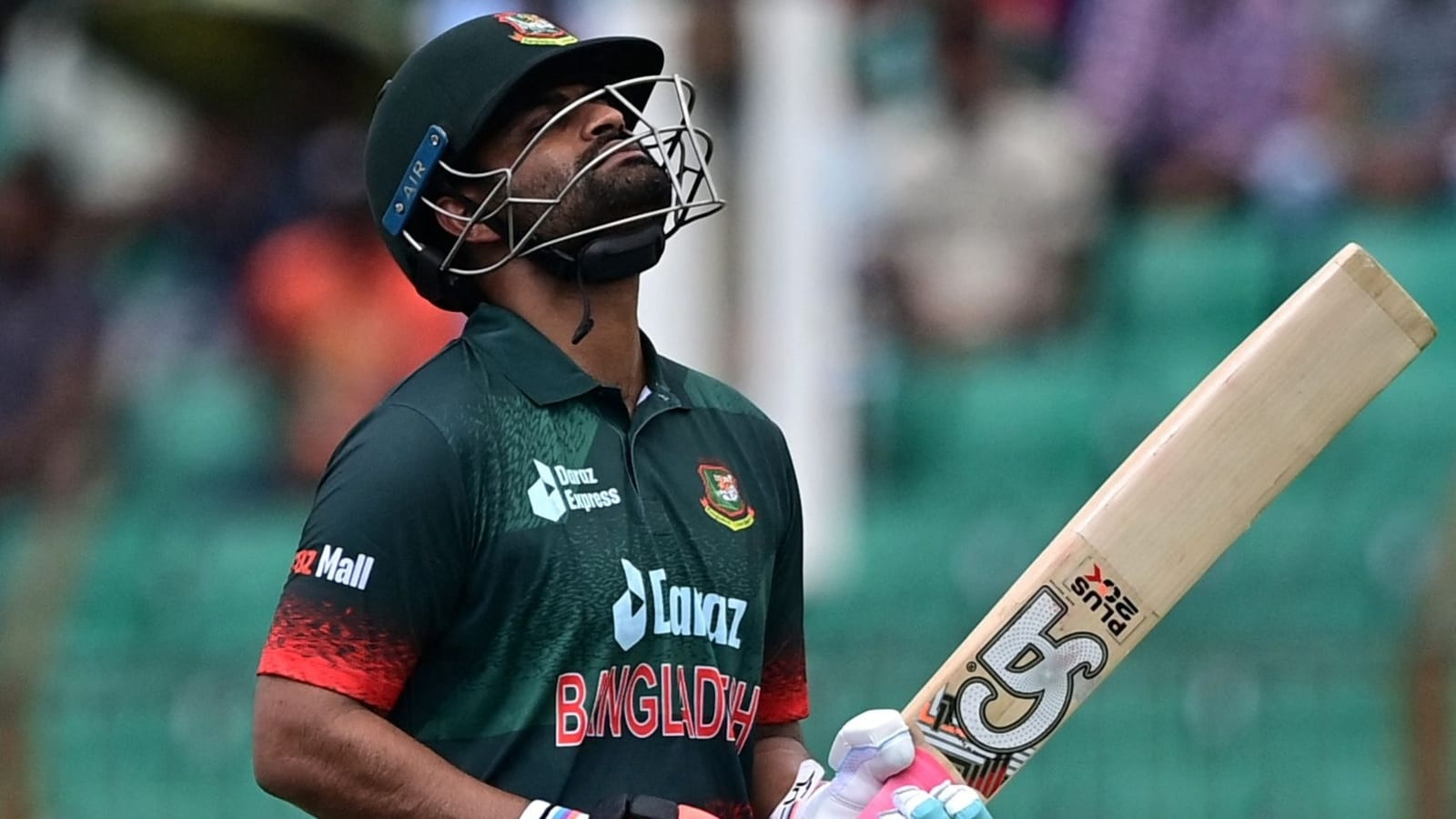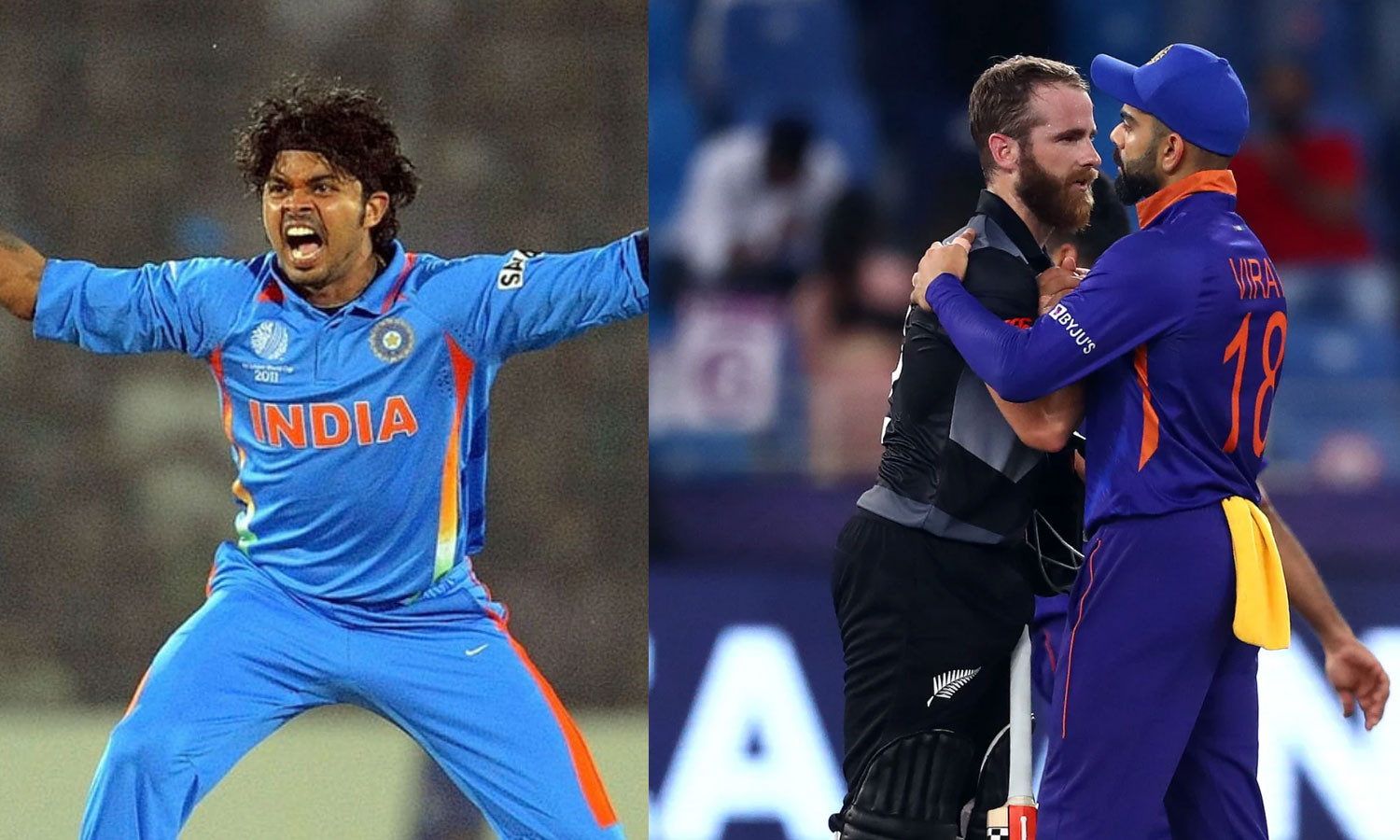The last year has been particularly dark for Bangladesh's most celebrated opener. Now he's just trying to enjoy what's left of his career.
It is the 2024 BPL final. The mood in the packed Shere Bangla National Stadium is one of anticipation. Fortune Barishal, hunting for their first title, are chasing a moderate 154 against four-time champions Comilla Victorians.
Barishal have been labelled Dad's Army this season for fielding the likes of Mushfiqur Rahim, Mahmudullah and Shoaib Malik - all 36-plus - and being led by Tamim Iqbal, who's just shy of his 35th birthday.
Tamim starts the chase by trying to reverse-sweep left-arm spinner Tanvir Islam, Comilla's best bowler of the tournament. But he misses and the ball goes to the boundary for four byes.
Tanvir is expecting the usual Tamim start, the sedate, diligent sort he has made for years now. That's what BPL owners have come to rely on and want, because T20 cricket in Bangladesh is played very conservatively.
But Tamim has been refreshingly aggressive this BPL season, compared to the last, especially in the powerplay, where he hits nine sixes against only three in 2022-23. Two of those sixes come in Tanvir's next over, the first a throwback to when Tamim started out, when he didn't have the range of shots he later developed and would often skip out of the crease to deposit the ball over long-on.
Tamim is on 25 off 21 balls when Moeen Ali comes on to bowl his offbreaks. Tamim launches his old friend for a six and two fours, and although he falls to Moeen, Barishal now only need 6.5 an over to win, which they do with an over to spare.
Their maiden title has been the product of expert planning and a rare BPL triumph without the intervention - or interference - of team owners. It is also a first T20 league title for Mushfiqur, Mahmudullah and Mehidy Hasan Miraz. The moment, however, belongs to Tamim.
The Comeback Kid
When we spoke for this story a few weeks after the season, he gave his senior players credit for the team's success.
"When we made the team in September [2023], a lot of players were not in the favourites' list of other BPL teams. We showed that belief in them and it paid off big time. We had a great mix of youth and experience. We knew we would react better in tough situations. Seniors guided us in tough situations. We didn't start well. Till the end of the league phase, we were always one match away from elimination."
A difficult season had an unexpectedly successful end. The events of the previous nine months could easily have pushed Tamim into a corner. Instead, he came out guns blazing, reminiscent of the fearless teenager from the 2007 World Cup, back when he had nothing to lose.
A Career Defined by Resilience
At 35, Tamim is coming to the end of a long and illustrious career. It is not hyperbole to regard him as one of the major architects of modern Bangladesh cricket.
Initially, he brought sturdiness and reassurance to a top order that had never known it. More than half the players who batted in the top seven of Bangladesh's ODI team from 1986 to 2006 were tried as openers and not many succeeded.
Many fans will remember Tamim as the flashy opener whose quickfire fifty helped Bangladesh to an iconic win over India in the 2007 World Cup. But that tournament also taught Tamim that his game wasn't ready for international cricket. That he had to rebuild his batting almost from scratch. For the next 12 months he worked on becoming a Test opener, taking the first steps towards transforming Bangladesh's perennial defeatist mentality into something close to that of a modern, professional outfit.
Tamim's career really took off in 2010, when he scored four centuries across formats against India and England. He was gutsy, was scoring runs, spoke English fluently. He was one of the first Bangladeshi cricketers to sledge back and not back down from confrontation.
His career in both red- and white-ball formats flourished simultaneously and showcased his versatility - he had different approaches in both. He loved taking on top bowling attacks. But an often rickety middle order meant that he also had to learn to grind. A few years into his career, the early flamboyance was all but gone.
Tamim quickly became a role model for aspiring cricketers all around Bangladesh. One of them, Tanzid Hasan, is now in the Bangladesh side.
Tanzid's nickname happens to be Tamim. This owes to Bangladesh's well established nickname (daak naam) culture, where an additional name - a term of endearment - is given to a child by their family; it isn't because his hero is Tamim. Tanzid was born in 2000, when Tamim was only 11. But as Tanzid grew up, he withstood his father's wrath for playing cricket, and modelled his game after Tamim's. Last year he replaced Tamim in the ODI World Cup squad.
From Captain to Controversy
From role model, Tamim graduated to captain. Shortly after Mashrafe Mortaza resigned in 2020, Tamim was given the task of leading Bangladesh through the ICC Super League to ensure automatic qualification in the 2023 World Cup. Bangladesh qualified comfortably, finishing third on the points table. Under Tamim, they beat West Indies, Sri Lanka, Zimbabwe, Afghanistan, South Africa and Ireland across two years. They only dropped points against New Zealand and defending champions England. Their series win in South Africa in 2022 was a milestone, coming against the background of Bangladesh's abysmal record in that country.
Tamim led from the front with the bat as the team's leading run-scorer, although his strike rate dropped slightly, reflective of an enhanced sense of responsibility. He also led his bowlers superbly, often setting aggressive fields for his fast bowlers, and seemingly becoming the first Bangladesh captain to realise that his pace attack could win him matches too. Bangladesh's six fast bowlers combined to take 152 wickets at 28.42 in this period.
Tamim, however, was disappointed with the lack of acknowledgement and celebration of this run. He felt the team's success in ODIs was being taken for granted - by the public, the media, and even the board - despite it being the only format where Bangladesh had progressed over the last 15 years. He didn't say anything publicly but close observers could sense some unease between the board's officials and Tamim.
Nobody, though, was prepared for what was to come.
A Tumultuous Retirement
In July 2023, Bangladesh was six months away from parliamentary elections. The exact date for them was to be announced in November, but already pressure was rising on the government of Sheikh Hasina - who has since been deposed - to correct its democratic course. There were accusations that the government had clamped down on freedom of expression, on peaceful assembly, and was responsible for enforced disappearances and extrajudicial executions.
Usually Bangladeshis don't need an excuse to talk cricket but back then, against this roiling political backdrop, a home series against Afghanistan wasn't quite enough, and cricket was very much in the background. Until, that is, an interview with BCB president Nazmul Hassan dropped on the day of an ODI in that series.
Earlier in the year, Hassan's gossipy revelation that Tamim and Shakib Al Hasan don't speak to one another got people talking. Now in this interview, he accused Tamim of being "unprofessional".
The day before, Tamim had said he wanted to play the ODI against Afghanistan despite not having fully recovered from a back injury. Hassan questioned his injury and claimed that coach Chandika Hathurusinghe was also unhappy and had spent half an hour "shouting at" Hassan about it.
By the time Tamim and I met in September last year, as Bangladesh prepared for the World Cup, he had lived out a whole career, having quit the captaincy, retiring, unretiring, and now about to return to the Bangladesh team. Naturally, he wasn't keen to talk about those two days in July.
"We are in such a stage that it is not the right time to talk about it. I will speak about it later - if I am fit, if I am okay. The team is going to the World Cup. I think all these things [off-field controversies] can stop. We concentrate on the cricket.
"Everyone knows what happened. The prime minister called. We had a discussion. It was almost impossible for me to say no to her. And then things changed. That's basically it."
Of course, it wasn't as straightforward as that. It takes a lot to get the attention of the country's prime minister, especially when she already has so much on her plate. And yet, an interview by the board president where he laid into one of the country's biggest cricket stars, briefly became, in this turbulent political climate, one of the top priorities in Sheikh Hasina's bulging in-tray.
A day after that match against Afghanistan, Tamim announced his international retirement in a teary-eyed press conference at a hotel in Dhaka. In a small room packed to capacity with journalists, cameras, Tamim's friends and even some fans, he read out a prepared statement. He didn't take any questions and didn't answer his phone for a while.
It was only after seeing numerous missed calls from Hassan and his former captain Mashrafe that he resurfaced.
A member of parliament from the Awami League at the time, Mashrafe told Tamim that Sheikh Hasina wanted to meet him. The former prime minister is an avid cricket fan, known for dropping important government work to watch cricket. She is also a big Tamim fan. There's a story that once when Tamim was approaching an ODI century, she sat on a prayer mat till he got there.
The next afternoon, Tamim and his wife went to meet Hasina at her Gonobhaban residence in Dhaka. Mashrafe and Hassan were also present. Tamim came out of the meeting to announce that he was reversing his decision to retire. It was hard to say no to a prime minister, especially Hasina, who had stood by cricketers. And Tamim was likely touched by her gesture of calling him and his wife to her home.
He made 44 in his return match, against New Zealand, but informed the selectors to keep his back injury in mind when selecting the World Cup squad. He knew there was enough time before the World Cup for his back to heal, but still wanted to show the selectors he wasn't hiding anything. Three days later he was left out of Bangladesh's World Cup squad on account of this persistent back problem.
A day later, Tamim took to Facebook to say his piece.
The Shakib Fallout
The story goes that just before the squad was announced, Tamim and Shakib were shooting a commercial together. As Hassan had revealed, they weren't talking to each other. At some point during the shoot, Tamim got into a heated argument on the phone with a "top BCB official".
"The person on the other side of the line told me that I might be dropped for the Afghanistan game [Bangladesh's first in the World Cup], and even if I play, I may have to bat down the order," a visibly upset Tamim said in the Facebook video.
"I said to him that I was in good shape, and you are talking about something that's almost two weeks away."
Shortly after the video went up, Shakib twisted the knife, just hours before the team was to leave for the World Cup. In a television interview, he landed one punch after another at Tamim, calling him "childish" and "not a team man".
Tamim didn't respond to Shakib's comments. Not then, nor during or after the World Cup, remaining quiet even when Bangladesh crashed out and Shakib was blamed for it.
Reflecting on a Career
Our interview last September was at his house in the old Defence Officers Housing Society in north Dhaka. Tamim had been through so much by then that I wasn't sure what mood I would catch him in. But he broke the ice with a joke, which set me free to talk through his career and what was left of it.
Tamim's first major contribution to Bangladesh cricket was having an open mind. It would have been very easy for him to rest on his laurels after the 2007 World Cup, like so many others had after impressing early, including Mohammad Ashraful. Tamim, however, was hungry. He agreed with coach Jamie Siddons' assessment that he would have to turn his batting inside out to become a Test cricketer.
Which is what he did, batting in the nets for hours in the newly built indoor facilities at the Shere Bangla Stadium. Those sessions in 2008 and 2009 helped expand his range of strokes and set the ball rolling for a stellar career. His batting right after that phase was breathtaking at times, not least the 151 in the Mirpur Test against India at an 80-plus strike rate.
Soon after came the two hundreds in England. He scored 268 runs in a two-Test series at a strike rate of 96.4, which was among his finest batting efforts, and up there alongside the 2016 century against England in Dhaka, the first time Bangladesh beat England in a Test. Very different conditions, but Tamim feels the Manchester hundred in 2010 might be the best of the lot.
"I batted better in Manchester than Lord's. I had zero idea playing against the Dukes ball. It was my first Tests in England. It was fun batting out there. Zero expectations, compared to later.
"I needed a lot of skills to play that innings in 2016. A lot of courage to play certain shots. Manchester was the better innings, but Dhaka was most difficult."
Over the years, a key realisation was about what worked for him in terms of preparation.
"You need to know yourself. It is the most important thing. You are talking to a 35-year-old today. There will be a lot of difference between the 25-year-old you spoke to back then. He will probably say he needs to do a million things. A 35-year-old will tell you: yes, work hard, but you also need to know what suits you.
"It depends on your personality. For example, I used to bat for a long time. Then came a time when batting for 30-40 minutes was fine for me."
The biggest difference Tamim says he has seen in the last 15 years, not only in himself but his generation of Bangladesh cricketers, is their professionalism.
"Even seven or eight years ago you needed a headmaster [to monitor]. Someone had to tell them, 'You need to do this, you need to do that.' Credit must go to the younger players, and some of the senior players, for this change. I don't think we need to be told the way we used to.
"You will see people doing their running and gym on their own. They work hard on their batting on their own. This has been the biggest change."
Leaving a Legacy
It's easy to forget how long Tamim has been around, and how much of Bangladesh cricket he has borne witness to first-hand. He was eight years old when his uncle Akram Khan led Bangladesh to the ICC Trophy win in 1997, a seminal moment in the country's sporting history. Akram became a household name afterwards. Tamim's older brother, Nafees Iqbal, also played Test cricket, although both say Tamim is the family's most talented.
Tamim's legacy, coupled with his family's sporting history, could on the face of it potentially be a burden for his children, but he keeps it light for his son and daughter. Modern parents, he thinks, are too competitive and put pressure on their kids.
"You have to be very, very lucky to play for Bangladesh. Many cricketers play the game but only a handful get to represent the country. When I go to a cricket academy or when I sometimes see kids playing football or cricket, I see a lot of their parents putting their seven- or eight-year-olds under so much pressure. 'Why can't you do this, why can't you do that?' they ask the kids.
"I understand that they have never actually played the sport. Maybe they watch Messi and Ronaldo and they want their son to become like that. If I was told that when I was that age, I would start hating sports. I don't think it's the right way. Playing the sport, you learn that everything is not in your control. It won't work if you force your children.
"I let my kids enjoy whatever sport they want. I don't even go to my son's training sessions. If he is playing cricket, I don't go with him. I play with him at home or our neighbourhood park, but not to his training sessions. I don't want to sit on top of his head, telling him what to do."
Given the career Tamim has had, the bar he has set for all the openers following him is high. He didn't have many Bangladeshi openers to emulate when he made his debut in 2007.
"I am extremely proud and thankful. I have always said that I am very lucky to have all this. From a cricketing side, I have two emotions: I have good emotions and I have a sense of not being able to achieve things. I think it is important to have that emotion too. Nobody is perfect. There are things I could have achieved or done better, I could have been happier. I have regrets like anyone else. [But] I have happiness too."
Tamim can give the impression of never being happy, never satisfied, with what he has achieved. While this can be a good thing, driving you to higher levels. But it can also put you under a lot of mental strain. I asked him why he is never content, and Tamim took my question as a compliment.
"It is actually one of the nicest questions I have received in my entire career. I don't know what to say. You are very right. I am extremely hard on myself. I wish I could have not been so hard on myself. If I wasn't, I could have enjoyed it more. I always set a good standard, maybe that's why."
He admitted that the way he treated himself during the 2019 World Cup made for a learning. He couldn't convert his starts, resulting in an under-par tournament. Tamim had a great run in ODIs from 2015 to 2018, so he was looking forward to the World Cup. When the runs didn't come, he slipped into deep introspection. "I am working on this, within me, that I shouldn't go that hard on myself. At least whatever cricket I have left, I want to enjoy whatever the result is. Knowing myself, I will still go hard," he said, laughing at himself.
The BPL Encore
A few months after our last interview and following the 2023 World Cup, Tamim strode back into form in the BPL. He didn't train much in the lead-up, playing a bit of taped-tennis-ball cricket with some friends.
He ended up as the tournament's highest scorer, with 492 runs, also the highest by a BPL captain in a single edition. Given charge of building the team, he asked Mushfiqur for help in taking care of field settings and bowling changes in most games, so he could be free to handle overseas players and to bat as freely as he did before. He was a captain-cum-team-director, which potentially teased a future for him once he is done with playing. Tamim's vast batting knowledge, the transformations he has undergone, the experiences he has had, might mark him out as a future batting coach. But he also looks the most likely among the current Bangladesh players to own a BPL franchise.
Barishal had to win two games in the playoffs to reach the final. Tamim was nervous but didn't want to show it to his team-mates. "Before the final I realised that all the players will look at the captain. We had a few overseas players who had never played in a [T20 franchise league] final. I couldn't show that I was nervous in the final, so the moment I walked into the ground, I told everyone that we were going to win.
"Sometimes you have to act to give a positive vibe to the team even though you are nervous inside. The positivity spread around the team."
After the BPL win, he went on to lead Prime Bank Cricket Club in the Dhaka Premier League. After one of the matches, Bangladesh's current captain, Najmul Hossain Shanto, spoke to Tamim about him returning to the national team soon.
Tamim hasn't spoken about retirement again. The BCB, now in limbo after the change of government, hasn't revealed a plan for him, and the Bangladesh team management is not saying anything for now.
The Uncertainty of the Future
Retirement is a curious phenomenon for cricketers from the subcontinent. The game does not let them go, and neither do they let the game go. Despite being a young Test nation, Bangladesh has seen its fair share of retirement dramas. Big names like Mashrafe and Aminul Islam never retired officially, while Javed Omar announced his retirement after playing a friendly match with journalists in 2014, seven years after his last international match.
For a few hours in July 2023, Tamim experienced life as a retired cricketer. Since then, he has starred in a BPL title win, and remains active in domestic league cricket. Shanto, increasingly an important voice in Bangladesh cricket, wants Tamim back in the national fold. If nothing else, this period will be an interesting footnote to Tamim's career. It may remove the bitter taste of 2023 and give him the ending he deserves.
Mohammad Isam is ESPNcricinfo's Bangladesh correspondent. @isam84
© ESPN Sports Media Ltd.

















